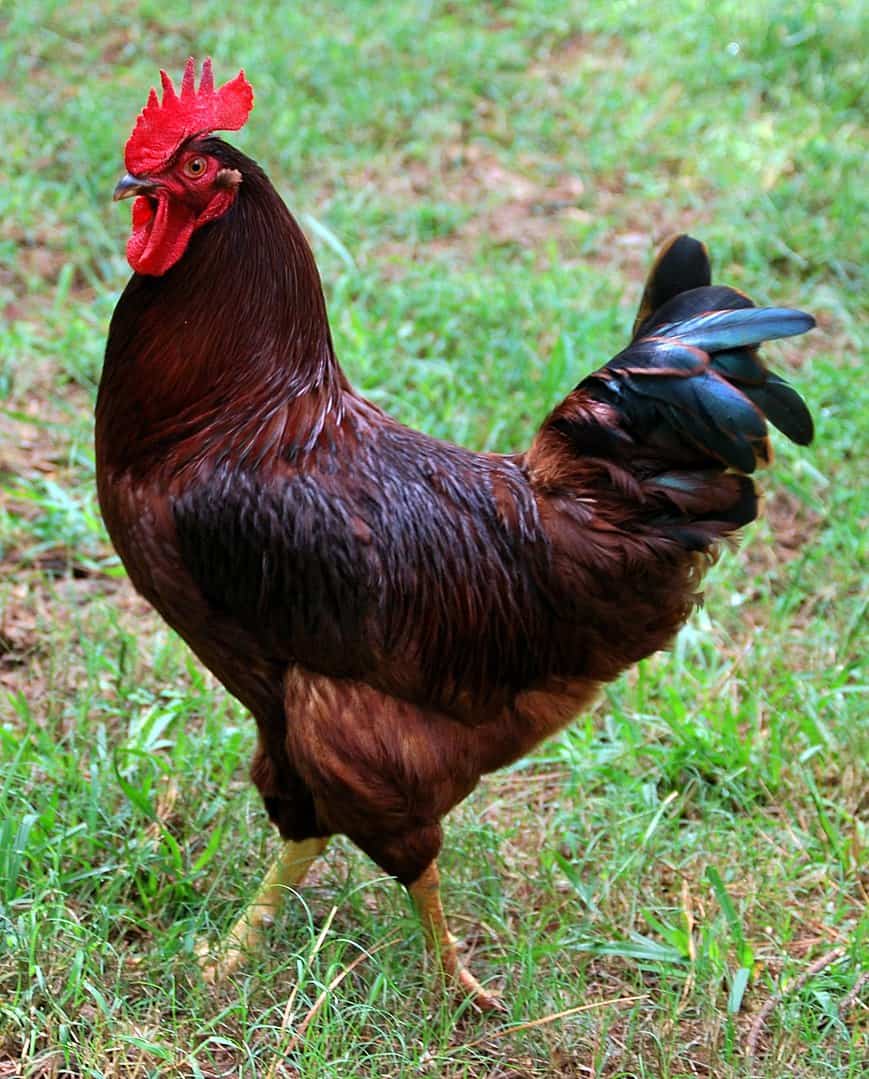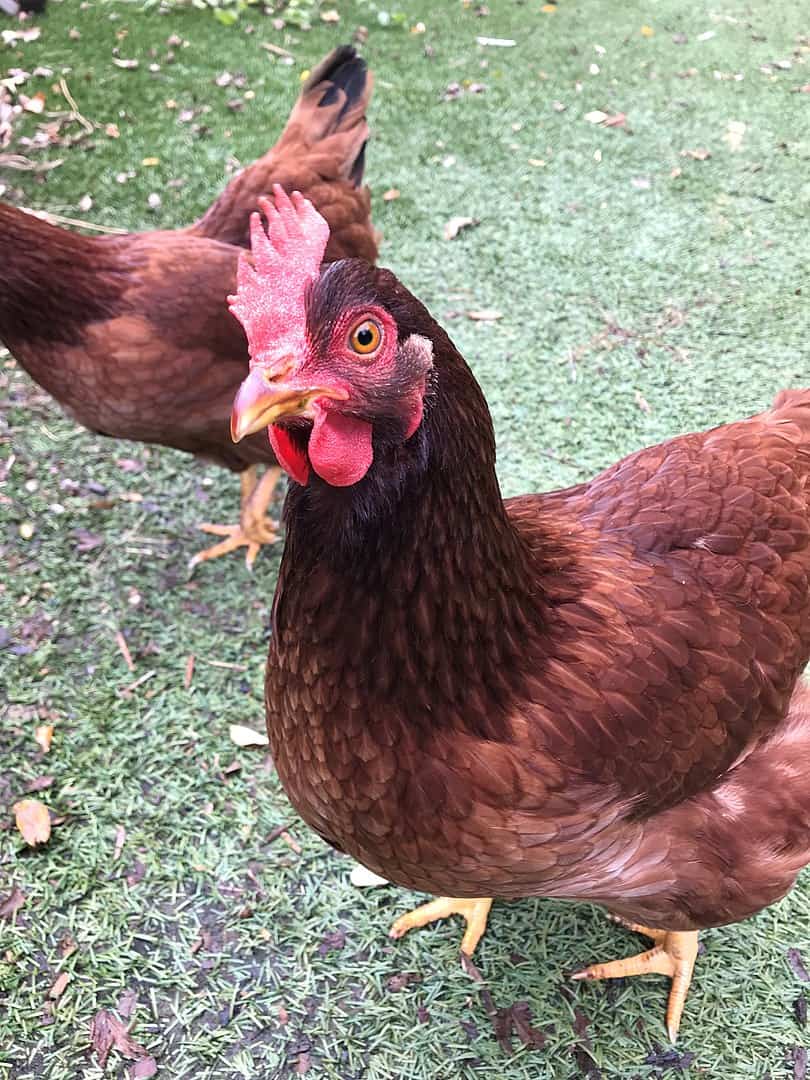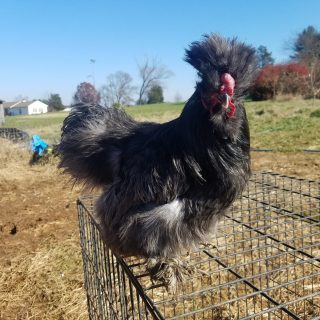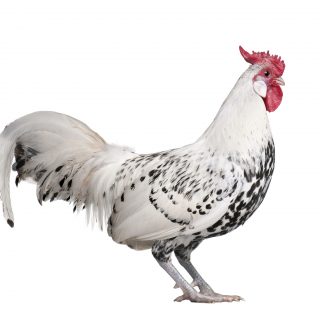The Rhode Island Red is one of, if not the, most well known chicken breeds. That's for good reason, too! They are great layers, a friendly and hardy breed, and can live just about anywhere. These qualities make them a particularly easy to care for chicken.

But other than the name and their color, which is in their name, what do you really know about the Rhode Island Red? This is your ultimate guide to Rhode Island Red Chickens.
Everything About The Rhode Island Red Chicken
To get you acquainted with raising Rhode Island Red chickens, we wanted to cover 3 important areas; what do they look like, what is their personality and temperament like, and what is the Rhode Island Red used for?
Let's start with their most distinguishing feature; their appearance.
What Do They Look Like?
The first thing you notice when you see a chicken is what they look like.
Color
We'll start with the most obvious feature; which is their color. The Rhode Island Red is, obviously, red. It is generally a darker, deeper red, like burgundy than a bright, fire engine red.
Hens are a pretty uniform red color. Whereas, roosters will sometimes have color variations in their saddle feathers and tail feathers. These color variations can vary from darker or lighter shades of red all the way to a dark, shimmery green.
In both hens and roosters, their skin is yellow. They also have yellow beaks, yellow legs, and yellow feet.
Size
The Rhode Island Red is considered a large breed chicken. Large breed chickens are ideal for meat birds. Like most breeds in the animal world, the males of the species are a good bit larger than the females. That is no different with the Rhode Island Red.
Interestingly, this breed is so popular that they have also been breed down in size. These made bantam chicken versions are just the like full size breed only about half the size.
Rhode Island Red Rooster vs Hen
What are the differences between the RIR roosters and hens? First, they have a significant size difference. Rhode Island Red roosters tend to clock in around 8.5 lbs. Hens tend to clock in smaller at around 6.5 pounds.
Color wise, while both roosters and hens are the typical red color, roosters tend to be a deeper, darker red with a green sheen on their tail, hackle and saddle feathers. While, the hens tend to be a slightly lighter red all over their entire body.
Additionally, like with other chicken breeds, roosters will have larger combs and wattles than hens.
American Poultry Association (APA)
This breed has been officially recognized by the American Poultry Association and, in the early 1900s, was entered into the Standards of Perfection. So, do not be surprised if you happen to see some at an APA sanctioned show someday.
Comb & Wattles
They also have a bright red single comb. A single comb is one of the more common types of chicken combs. It starts at the edge of the beak and is a single strip all the way to the top of the head. It is recognizable by several ridges or spikes that run it's length.
In addition to a bright red single comb, they also have a set of bright red wattles. These wattles are located directly under their chin and run to the back of the jawline.
Chickens use their combs and wattles as part of their body's regulatory system. Similar to a goat's or cow's horns, blood flows through the looser, thinner skin, is cooled or warmed, and then runs back through the body helping the chicken keep a constant temperature.
Need some help keeping your chickens health and care taken care of? Check out the Organized Chicken Keeper for an easy to follow system.
What Are They Like?
We split this into two categories; personality and temperament.
Personality
You will find, the longer you raise chickens, that they each do indeed have their own little personalities. The Rhode Island Red is pretty calm and laid back. At least for a chicken, anyway.
They are also pretty docile. You're not going to find too many of them that are overly irritable or aggressive. They don't typically attack kids or pets. They make great additions to backyard flocks for this very reason.
Temperament
In addition to having pretty great personalities, they also have great temperaments. Unlike some other egg production hens, they do not tend to go broody too terribly often. That means you will have less times when they do not lay eggs.
They adapt really well to coop life. They learn where to go at night and where they can roam in the day. Reds can live pretty much anywhere but are not big fans of really hot areas. However, they do well in the cold and are very cold hardy.
What Is Their Purpose?
Most often people get chickens for one of two reasons. They either want as many eggs as it takes to keep their family fed or they want to raise their own meat source. I guess some people just want a pet too, but that's not too terribly common.
Rhode Island Reds are great because they are what is called a dual purpose chicken breed. That just means that they are suitable for both meat production and as reliable egg layers.
In fact, they are such solid birds that they have been used to create a whole slew of hybrid production breeds such as red star chickens.
Meat
As we mentioned above, Rhode Island Reds are a large breed chicken; growing anywhere between 6 ½ to 8 ½ lbs depending on if it's a hen or rooster. They also grow very quickly, especially if you have them on a meat bird diet.
Large breed chickens make great meat birds. Because they get so large so quickly they are a very affordable meat source.
Eggs
The more common purpose for chickens, at least in backyard flocks, is that of egg production. And, boy, do Rhode Island Reds produce some eggs. With just a few hens, you can feed a family of 5 eggs for breakfast every day of the week.
Since they do not tend to go broody, they stick to a pretty consistent schedule when laying eggs. Rhode Island Reds will typically lay between 200 and 300 eggs a year. They lay brown eggs that are considered to be extra large eggs.
If you want to get chickens for eggs, the Rhode Island Red is a fantastic choice.

What Care Do They Need?
When you keep chickens, you want to make sure they are well cared for. Here are some quick tips to make sure they have a happy and healthy life.
Diet
Chickens need to have a consistent and reliable source of food. They can get a large portion of their needs just from free ranging, but they may not get all of their nutrients that way.
Fortunately, you can find a decent quality layer feed in any farm store. They are made specifically for laying hens and will meet all of their nutritional needs. You can tell if they are getting enough nutrients when they are laying extra large brown eggs with bright (not pale) yellow, almost orange, yolks.
Coop
Your chickens need to have access to a warm, dry coop or living space. It should be well ventilated and cleaned regularly. A chicken coop can get pretty gnarly real quick if not maintained regularly.
The general rule is each chicken should have between 2 and 3 square feet of space in the coop. We have found they are happier and healthier if you can get it closer to 4. If you also have a run for them, try and keep that space to around 12 square feet per chicken.
General Health
Chickens are susceptible to a lot of respiratory diseases. Some of them are in the soil. Some of them can be transmitted by wild birds. It's common and there's not a lot one can do other than keep their living area as clean as you can.
With that being said, Rhode Island Reds are a pretty healthy and hardy breed of chicken. They do not seem to have any more health issues than any other breed of chicken
What Breeds Are Similar To The Rhode Island Red?
Rhode Island Reds aren't the only chicken that is suitable to the backyard or makes a great dual purpose chicken.
Black Australorp
Black Australorps are fantastic dual purpose chickens. They grow to a similar size as Reds and may lay eggs even more often.
Speckled Sussex
The Speckled Sussex is another similarly sized dual purpose breed of chicken. They lay a little less often than Reds, around 3 to 4 times a week. They are incredibly hardy and can live for a long time. We had a girl for 8 years before a predator finally picked her up.
Common Questions
Here are some of the most commonly asked questions we came across while researching for this ultimate guide.
Are They Friendly?
As we mentioned above, the Rhode Island Red chicken is pretty docile and laid back. They are one of the more friendly breeds of chickens out there. They make great backyard chickens because they integrate well with young kids and pets.
How can you tell if a Rhode Island Red chicken is a rooster?
The obvious sign is that the Rhode Island Red rooster is larger in size than the Rhode Island hen. They also usually have larger combs, wattles, and more impressive feathers. These are the quickest ways to tell if you have a hen or a roo.
Are they noisy?
No, they are not super noisy. In our experience, they can be a little chatty, but don't overall make much noise.
Do Rhode Island Red chickens get along with other chickens?
Yes, they can get along with other chickens. However, in our flock, we have noticed that they tend to heavily pick on other chickens - both other breeds and other chickens of their same breed as they are establishing a pecking order.
Are Rhode Island Red Chickens Cold Hardy?
Yes, they are known for being very cold hardy.
What are they known for?
They are known for their fantastic laying ability. However, they are also considered a dual-purpose breed as they are big enough to be used for meat as well.
How many eggs do Rhode Island Reds lay a day?
Like we mentioned above, Rhode Island Reds are prolific layers. They usually lay in the 200 to 300 eggs per year range. That breaks down to around 5 eggs a day per hen.
What age do production Reds start laying eggs?
Chickens usually start laying eggs reliably around the 18 month mark. You can also spot certain signs when your chicken is about to start laying eggs.
Conclusion
The Rhode Island Red really is a pretty magnificent bird. They make great additions as a backyard pet for the family. You can also raise them as a reliable source for eggs. They also grow really large and make great meat birds.
If you are looking for the perfect breed to grow your flock or you're just getting started, Rhode Island Reds are a great place to start! Do you have any Rhode Island Reds? Let us know your favorite chicken in the comments below.
If you need more help with taking care of your chickens, check out The Organized Chicken Keeper for a complete system for managing their health through keeping their supplies stocked and coop clean.


